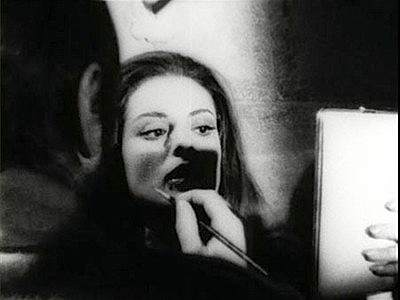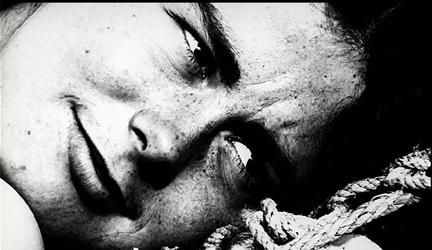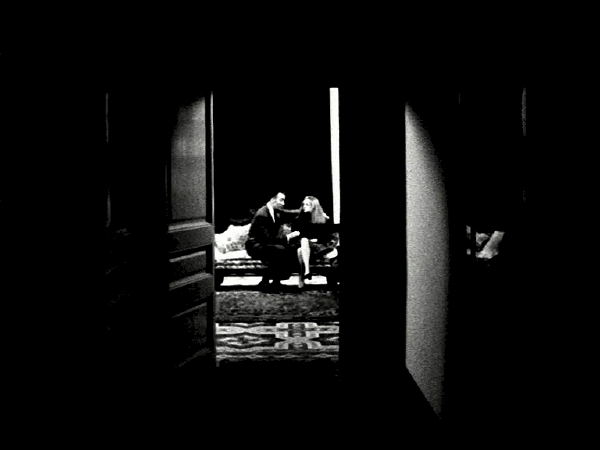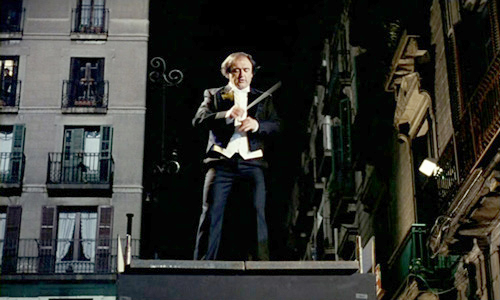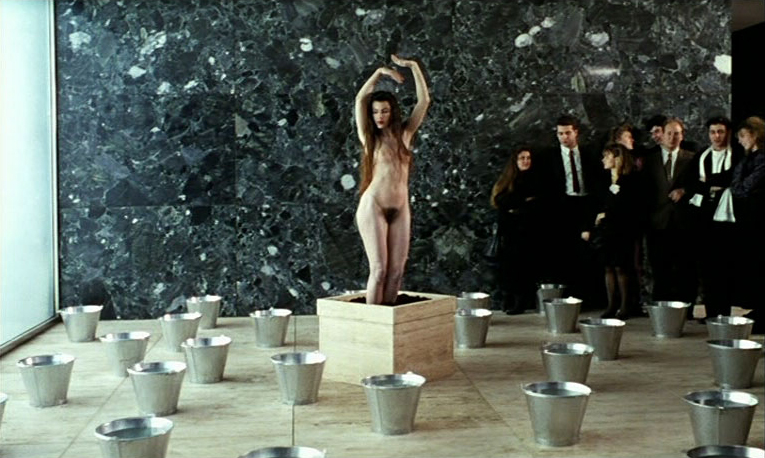From the Chicago Reader (November 10, 2006). — J.R.
Pere Portabella: Cinema From the Spanish Underground
The first North American retrospective of Catalan filmmaker Pere Portabella started last week at the Gene Siskel Film Center, and it’s one of the year’s biggest cultural events. None of his films has ever been screened in Chicago, and none has ever been released anywhere on DVD or VHS. All five of his features are showing here (though none of his ten shorts), and if you don’t see them now, chances are you never will.
Most of Portabella’s films can be classified as experimental, though they have little in common with the films usually given that label, which tend to be nonnarrative and shot in 8- or 16-millimeter or on video. All of his features are in 35-millimeter and use narrative, though they never tell a complete story. They all have rich sound tracks that go in and out of sync with the images, sometimes reinforcing what we see, sometimes contradicting it. They all drift smoothly, often unexpectedly, from narrative to reverie and from fiction to documentary, interjecting rude shocks along the way. They’re full of comic incongruities as well as creepy interludes, and they’re all intensely physical experiences — sounds and images that assault or caress. Their formal brilliance reflects Portabella’s long involvement with painting and music, and their intellectual and political themes are almost always implicit.
My favorite Portabella film, screening this week, is Cuadecuc-Vampir (1970), a black-and-white silent about the shooting of a Dracula film with Christopher Lee (Count Dracula by celebrated hack Jesus Franco) that becomes much more than a documentary. It glides effortlessly between telling parts of the Dracula story (with Dracula as an implicit stand-in for General Francisco Franco) set in a dank period location to providing a personal and ironic commentary on Count Dracula‘s production by focusing on stray details: a fan blowing confetti over a corpse, a ghoulishly made-up actress making a face at someone between takes, a bag of unspecified something crawling across a floor. Meanwhile, periodic sounds of jet planes, drills, operatic arias, syrupy Muzak, and sinister electronic droning ingeniously locate Dracula and our perceptions of him in the contemporary world, until the end, in the film’s only use of sync sound, when Lee reads a climactic passage from Bram Stoker’s novel. Recalling without imitating such classics as Nosferatu and Vampyr, the film uses high-contrast cinematography to evoke the dissolution and decay that strikes viewers who see those films today in fading prints. It all adds up to a kind of poetic alchemy in which Portabella converts one of the world’s worst horror films into one of the most beautiful movies ever made about anything. (It’s characteristic of his artistic integrity that he refused to allow Cuadecuc-Vampir to be used as an extra on a Count Dracula DVD.)
I first encountered this masterpiece at Cannes a little over 35 years ago, and I’ve been a sucker for Portabella’s work ever since. A year later I saw his even wilder Umbracle (1970) at Cannes. Portabella wasn’t at either festival because his passport had been taken away. He was one of the Spanish producers of the first feature Luis Bunuel ever made in his native Spain, Viridiana (1961). Denounced by the Vatican after it won the top prize at Cannes, the film created such a scandal that the Franco government confiscated or destroyed all of the official papers that identified it as a Spanish film and punished Portabella by taking away his passport for several years.
Born into a family of wealthy industrialists in Barcelona in 1929, Portabella has been closely tied to the city’s art scene for most of his life and has been a major patron of Catalan artists, including Joan Miro, the focus of three of his shorts. (One of his major collaborators is the prolific Catalan poet and playwright Joan Brossa, cowriter on the first three features.) He also served for many years as a senator in the post-Franco parliament. He started working in film in 1960, when he produced the first full-length feature of Carlos Saura (Los Golfos) and an early feature by Marco Ferreri (El Cochecito), followed by Bunuel’s Viridiana.
The first film he directed was the 1968 Nocturno 29 (shown at the Film Center last week), which inhabits a space somewhere between art cinema and experimental cinema. It stars Lucia Bose — an Italian actress associated with such art-house directors as Michelangelo Antonioni, Juan Antonio Bardem, and Bunuel — and exploits many of the tropes and ritzy settings associated with them and with Alain Resnais’ Last Year at Marienbad. It’s my least favorite Portabella feature, more provocative than achieved, but insofar as its dissimilar parts add up to something, it can be read as a kind of first draft of Umbracle — which itself was a kind of first draft of the 1990 Warsaw Bridge, his most recent feature to date (he’s now shooting a sixth, which he plans to show in Chicago in May).
Like Cuadecuc-Vampir and Umbracle, Nocturno 29 was made completely outside commercial channels and for the most part was shown clandestinely. Its anti-Franco stance is implied in the film’s title–it was made during Franco’s 29th year in power. That stance is even more apparent in the formally more adventurous Umbracle, which uses some Catalan at a time when speaking the language was forbidden. His opposition is more direct in the 1977 Informe General (General Report), a relatively conventional 158-minute documentary made after Franco’s death that attempts to deal with the enormity for Spaniards of his nearly 40 years in power.
Umbracle belongs to an international avant-garde subgenre of films made in the late 60s and early 70s that juxtapose disparate materials to spark a radical combustion. (Other examples include Jean-Luc Godard’s Sympathy for the Devil and Dusan Makavejev’s WR: Mysteries of the Organism.) The film adds up to a scream, expressing the frustration of living under Franco through the combination of widely diverse materials: statements by a Spanish intellectual about censorship, a Bunuelian tour of a shoe store, a traditional clown act, clips from a kitschy 1948 Spanish propaganda feature and silent American slapstick comedies, a parade of plucked chickens in an automated slaughterhouse, Christopher Lee taking hallucinatory trips around Barcelona. In the penultimate sequence a woman puts on a recording of Beethoven’s Pastoral Symphony and moves toward a telephone, then both the record and the image become “stuck”: the same four notes keep repeating, while the same fingers are seen from different angles, poised above the dial they will never reach.
While radical discontinuity is the main fare in Umbracle, a kind of radical continuity underlies the often bewildering and audacious shifts in locations and styles in Warsaw Bridge. It’s Portabella’s first color feature (there’s a brief patch of color in Nocturno 29), and his first feature in which the “enemy” isn’t Franco. If anything has replaced him, it’s probably the complacencies of commercial narrative cinema.
In commercial movies the standard logical flow is produced by style as well as content — a set of links composed of music cues and other continuities of sound and image that carry us smoothly across shot changes. Portabella highlights this process in Warsaw Bridge by retaining the links while sabotaging the narrative logic that usually justifies them. (One of its cowriters, Carles Santos, has created the music or sound tracks for all of Portabella’s features since Cuadecuc-Vampir.) The film also appears to be an anthology of his passions and interests and a somewhat ironic and funny portrait of his milieu.
At the center of Warsaw Bridge is a romantic triangle between a prizewinning novelist, a symphony conductor, and a university marine-biology lecturer, but the narrative crisscrosses more than follows these characters. In between it offers, among other things, meditations on Spanish architecture and landscapes, an outdoor concert where the conductor is on an elevated platform in a shopping arcade and the musicians are on nearby balconies, a lavish state party thrown for the novelist, a verbal chess match at the party, a credit sequence 20-odd minutes into the film, a concert inside a cathedral, extended lovemaking, a recitation of part of the novelist’s book, an opera performed at a gigantic fish market, a university lecture on algae, another opera set (though not staged) in a Turkish bath, a TV interview, a meal prepared and eaten by the three lovers, a film screening, and a plane trying to extinguish a forest fire. The images of operas and at least one of the concerts move gracefully in and out of sync with the music, and the opera in the fish market includes some spectacular bits with sharks and blocks of ice. Some of the dialogue and action segues into non sequiturs and nonsense. And whatever it all means, the whole thing is gorgeous.


